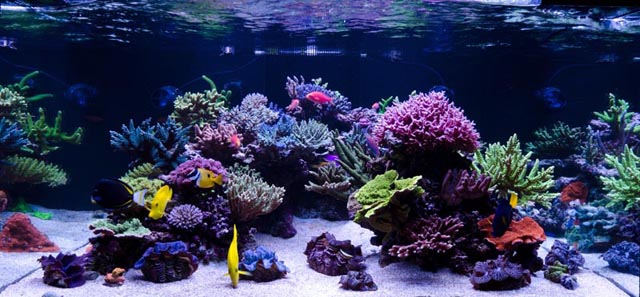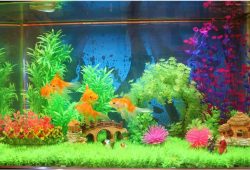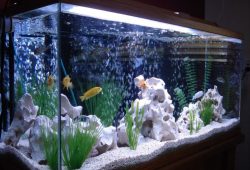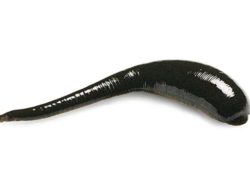Reefkeeping on a shoestring
This article tells you about Reefkeeping on a shoestring. Like many reef aquarium hobbyists, I am easily impressed by the gigantic hi-tech reef systems found in famous public aquariums like Waikiki, Monaco and our own London Aquarium. One of these mega-sized reef tanks must be on every reef hobbyist’s wishlist. However, when reality bites, it’s likely that most of us need to downsize our aspirations a little to the real world in which we live – and usually this means choosing a much more modest reef system.

Unfortunately, it can be very difficult to maintain a successful life-support system for sensitive coral reef subjects when you have to rely on using a small tank and very basic equipment. So it was really exciting to find a new approach that Roy Meeke has discovered to successfully set up and maintain an amazing little reef tank with the very minimum of equipment support.
Everything’s relative
In terms of size, all things are relative, and although reef hobbyists do have success with micro reef systems down to as small as 45 l./10 gal., these are usually refugiums attached to much larger reef tanks or tiny specialist systems for keeping limited types of subjects such as seahorses or mini invertebrates. A fully-fledged mixed reef community system needs to be much larger, and I would recommend, as a minimum, no smaller than 230 l./50 gal.
Roy’s system, a 76cm/30” cube tank, is designed on Leng Sy EcoSystem principals, so although there is a small sump refugium that adds a further 59 l./13 gal., giving a total water capacity of 510 l./110 gal., displacement by rocks, substrate, etc. still places this tank well under 455 l./100 gal. in net capacity terms.
Small as it is, it still manages to display a wide range of healthy, colourful reef subjects. What was immediately noticeable, however, was that while there was good coral cover, all were soft corals.
Roy explained that soft corals are rising in popularity due to increased restrictions governing the imports of hard corals. As the tank is one of the displays at his shop Interfish, he wanted to show just how effective a reef tank can be based solely on these easy-to-keep corals.
There are other advantages in specialising in such hardy subjects. There is no need for the strong, high-intensity lighting necessary with most hard corals, and especially SPS types. Nor is there the need for calcium addition using a CO2 reactor.
Furthermore, thanks to these corals’ tolerance of a wide range of temperatures, the only cooling necessary is good room ventilation.
Needless to say, quite large economies can be made both in savings on equipment purchase and running costs.
Partially substituting metal halide lighting with T5 fluorescent tubes, for example, represents substantial savings, while the omission of a calcium reactor and cooler simplify the system and substantially lower set-up costs.
The best of all…
Perhaps the biggest savings come in adopting the EcoSystem method of filtration. This totally natural form of filtration uses Caulerpa as an algal scrubber, which absorbs the waste products of fish metabolism and fixes them into plant tissue. This therefore prevents the accumulation of harmful ammonia, nitrites and nitrates, all the while stabilising pH.
This is accomplished by installing a refugium below the display tank containing live Caulerpa. Miracle mud – a carefully formulated material that includes trace elements, minerals and other components necessary to maintain a successful aquarium – is used as the substrate in the refugium and is an essential component of the EcoSystem method.
Lighting over the refugium is left on 24/7 to allow continuous photosynthesis. This has the benefit of reducing pH fluctuations that occur out of the normal photoperiod, as well as preventing sexual reproduction by the Caulerpa, thus lowering the risk of the algae crashing.
Economies from choosing the Ecosystem form of filtration, initially, are savings on equipment such as a skimmer plus a dosing system for additives. This latter is necessary when using a skimmer in order to replenish beneficial components such as calcium, strontium, iodine and molybdenum plus various trace elements that heavy skimming can easily remove.
Longer-term benefits, of course, are savings in maintenance/repairs of this equipment and purchase of expensive additives.
Similarly, pH fluctuations are often a problem in non-EcoSystem filtered reef systems requiring correcting by dosing kalkwasser during hours of darkness. This is also unnecessary when the EcoSystem method is applied, as pH remains stable throughout the full 24-hour daily cycle.
I asked Roy whether all of the economies he had made from not using the various pieces of equipment had, in practice, been successful. I mentioned the cooler, for example, which would seem to be necessary in the warm atmosphere of his shop.
Roy said that he fixed the heater-thermostat on the aquarium at 27C/80F, and for most of the year, this temperature is maintained. All of the other marine aquaria in his shop are on a centrally cooled system, but this tank relies solely on space ventilation.
“If there are a number of consecutive days when there are heat-wave conditions outdoors, the tank will slowly rise to 30ºC/86ºF. The corals and other tank subjects seem to cope OK with these conditions without any distress, and soft corals are known to have a better tolerance to high temperatures than hard corals.”
“What about adding calcium,” I continued, “surely there is a need to replenish calcium to maintain reef conditions?”
“Calcium levels in the tank are maintained satisfactorily at around 370-380ppm using my regime of regular 10% water changes at fortnightly intervals, as there is not a high demand for calcium by soft corals,” he said.
“All other beneficial components in the water which reduce over time are replenished by the same process, and by the Miracle mud in refugium. So in the absence of a skimmer, it’s possible to manage without any additional equipment for adding calcium or a dosing system for additives.”
Lighting conundrum
The unusual mix of lighting prompted me to ask about the thinking behind Roy’s choice. He admitted the tank’s dimensions presented quite a challenge.
The 76cm/30” tank length only allowed 24W T5 tubes to be fitted, hence the large number of twin tube hoods required. The depth of the tank, also 76cm/30”, necessitated the use of the 150W metal halide lamp.
“A conventional shallower tank of the same capacity could easily be satisfactorily lit with T5s,” he said. “Obviously, if I used the same tank for hard corals, I would need a 400W metal halide together with T5s, so even though the tank seems to be well equipped with lighting, it is not particularly brightly lit.”
One benefit of the unusual tank dimensions was that it simplified water circulation requirements. Roy found that the Aqualine 5000lph pump produced quite strong currents in the display area, with the force of the water diminishing very little when flowing the relatively short length of the tank. Two 1200lph Maxijets were all that were required to produce a total theoretical tank turnover of 10 times per hour.
He added: “I tried a larger-capacity Tunze water circulation pump, but the force was far too great for such a small tank.” Here again, Roy’s reef system design has provided a simple and economical means of providing another main essential of a reef aquarium – good water circulation.
Putting economies to one side, the main proof of any successful reef system is the health and vigour of the subjects and whether you can offer conditions that allow the widest choice.
In its present shape, Roy’s aquarium does not allow him to keep the more challenging SPS hard corals, though adding 400W metal halide lighting and a CO2 calcium reactor could easily redress this.
“In its present form,” said Roy, “I think this tank set-up offers a really good package that would appeal to both a beginner and someone more experienced.
“Soft corals and other sessile invertebrates like gorgonians, searods and colonial anemones are ideal easy subjects for it. They thrive in the conditions provided by Leng Sy’s EcoSystem method of filtration, constantly displaying full polyp extension, and are colourful, healthy and vigorous.
“The great success of the Leng Sy method is that the detrimental effects due to skimming are avoided, and the aquarium water reflects more closely the components that are found in the waters surrounding natural reefs.
“No better evidence is there than that of the sponge colonies, which have sprung up in the aquarium – these are normally absent in tanks with over-powerful skimming.
“The conditions seem to suit the fish also; I’ve never seen any as colourful as the ones in the natural healthy environment that this tank provides.”
Factfile
Aquarium vital statistics
The aquarium is a 76 x 76 x 76cm/30” x 30” x 30” cube with a capacity of 441 l./97 gal. Added to this is the sump refugium of 76 x 40 x 40cm/30” x 16” x 16” (water level 30cm/12”), which contributes a further 59 l./13 gal. The total water capacity before displacement is 510 l./110 gal.
Biological filtration
The Leng Sy EcoSystem filtration method is employed relying on an algae scrubber refugium with a substrate of Leng Sy-patented Miracle mud. The refugium is a standard Leng Sy pattern and contains Caulerpa and small amounts of live rock, plus two bags of Miracle mud. Roy recommends C. prolifera after experimenting with a range of other species. About 50kg of live rock in the display tank also contribute towards the biological filtration.
Chemical filtration
Not considered necessary; Roy does not use a phosphate remover as he believes any small traces in the system are beneficial to the Caulerpa.
Water changes
Partial water changes of 10% fortnightly using Tropic Marine salt mix/RO water.
Skimming
No skimming in line with EcoSystem filtration method.
Calcium/carbonate hardness management
Not considered necessary.
Water circulation
1 x 5000lph Aqualine submersible pump (filter return)
2 x 1200lph Maxijet submersible pumps
This gives a theoretical total water movement through the tank of 7400lph, with a total tank turnover of around 10 times per hour.
Lighting: Display tank
3 x D&D Mega Twin hoods, each fitted with
2 x 24W T5 fluorescent tubes (six in total)
1 x Aqua Medic 13,000K metal halide with 150W bulb (height above water 10cm)
Lighting: Refugium
1 x D&D Mega Twin hood fitted with
2 x 24W T5 fluorescent tubes
Photoperiod
Display tank: Total photoperiod nine hours: 1000-1900
Refugium: Lit permanently on a 24/7 basis
Cooling
Space cooling and ventilation only
This article was first published in the November 2005 issue of Practical Fishkeeping magazine.



